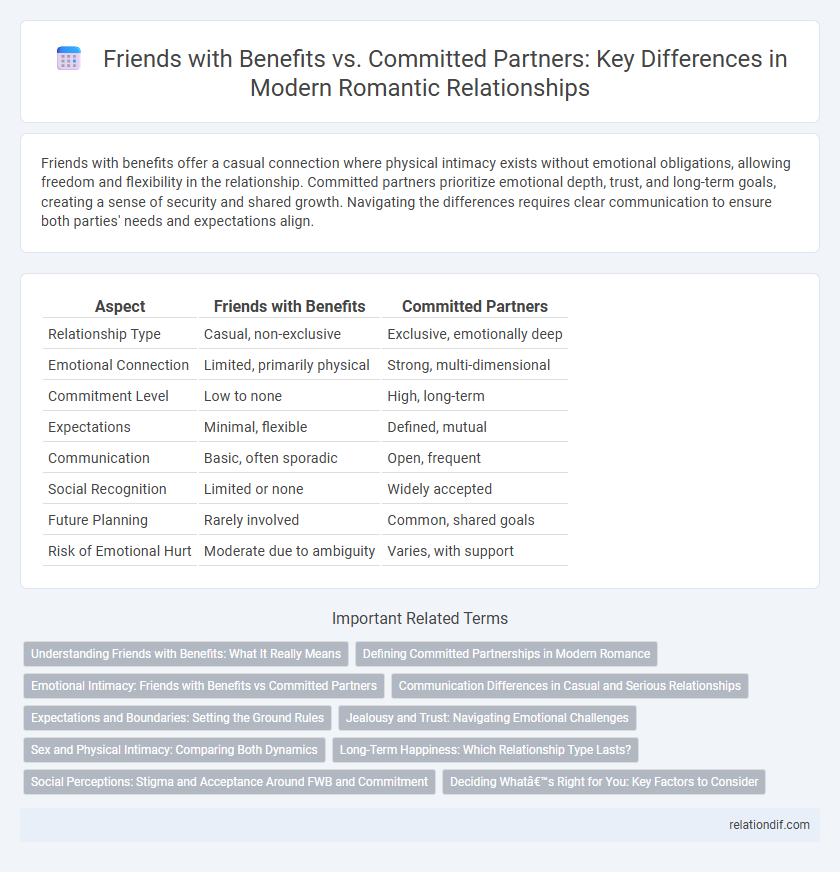Friends with benefits offer a casual connection where physical intimacy exists without emotional obligations, allowing freedom and flexibility in the relationship. Committed partners prioritize emotional depth, trust, and long-term goals, creating a sense of security and shared growth. Navigating the differences requires clear communication to ensure both parties' needs and expectations align.
Table of Comparison
| Aspect | Friends with Benefits | Committed Partners |
|---|---|---|
| Relationship Type | Casual, non-exclusive | Exclusive, emotionally deep |
| Emotional Connection | Limited, primarily physical | Strong, multi-dimensional |
| Commitment Level | Low to none | High, long-term |
| Expectations | Minimal, flexible | Defined, mutual |
| Communication | Basic, often sporadic | Open, frequent |
| Social Recognition | Limited or none | Widely accepted |
| Future Planning | Rarely involved | Common, shared goals |
| Risk of Emotional Hurt | Moderate due to ambiguity | Varies, with support |
Understanding Friends with Benefits: What It Really Means
Friends with benefits relationships prioritize physical intimacy without the expectations of emotional commitment or exclusivity found in committed partnerships. These arrangements emphasize clear communication about boundaries and mutual consent to avoid misunderstandings and maintain friendship dynamics. Understanding the key differences in expectations and emotional involvement helps individuals navigate the complexities of casual versus committed romantic connections.
Defining Committed Partnerships in Modern Romance
Committed partnerships in modern romance emphasize emotional intimacy, mutual trust, and long-term dedication beyond physical connection. Unlike friends with benefits arrangements focused primarily on casual sexual interactions without defined expectations, committed relationships involve shared goals, consistent communication, and a deeper sense of partnership. Key markers include exclusivity, cohabitation considerations, and joint decision-making on life plans, differentiating them from more transient or casual connections.
Emotional Intimacy: Friends with Benefits vs Committed Partners
Emotional intimacy between friends with benefits typically involves limited vulnerability and a focus on physical connection without deep emotional sharing. Committed partners generally develop strong emotional bonds characterized by trust, open communication, and mutual support, fostering long-term stability. This distinction impacts relationship satisfaction and expectations, with friends with benefits often lacking the emotional depth seen in committed partnerships.
Communication Differences in Casual and Serious Relationships
Communication in casual friends with benefits relationships often emphasizes boundaries, consent, and frequency, focusing on clarity to avoid emotional misunderstandings. In committed partnerships, communication typically centers around emotional support, future planning, and conflict resolution, fostering deeper intimacy and trust. The key distinction lies in the depth and purpose of conversations, reflecting the varying emotional investments and expectations.
Expectations and Boundaries: Setting the Ground Rules
Establishing clear expectations and boundaries is crucial in both friends with benefits arrangements and committed relationships to prevent misunderstandings and ensure mutual respect. In friends with benefits dynamics, explicit communication about emotional involvement, exclusivity, and frequency of contact helps maintain a casual connection without unintended commitment. Committed partners typically negotiate boundaries related to intimacy, communication, and long-term goals, fostering trust and emotional security within the relationship.
Jealousy and Trust: Navigating Emotional Challenges
Friends with benefits relationships often face heightened jealousy due to blurred emotional boundaries and undefined expectations, making trust fragile. Committed partners typically build trust through clear communication and mutual exclusivity, reducing jealousy and fostering emotional security. Navigating these emotional challenges requires understanding personal boundaries and being honest about feelings to maintain healthy dynamics.
Sex and Physical Intimacy: Comparing Both Dynamics
Sex and physical intimacy in friends with benefits arrangements often emphasize casual encounters without emotional obligations, promoting flexibility and freedom. In contrast, committed partners typically engage in sex as an expression of deeper emotional connection, fostering trust and long-term bonding. The physical intimacy in committed relationships tends to be more frequent, intimate, and emotionally satisfying compared to the often spontaneous and less emotionally charged encounters in friends with benefits dynamics.
Long-Term Happiness: Which Relationship Type Lasts?
Friends with benefits often provide short-term satisfaction but lack the emotional depth required for lasting happiness, while committed partners build trust and intimacy essential for long-term fulfillment. Research indicates that individuals in committed relationships report higher levels of life satisfaction and emotional well-being compared to those in casual arrangements. Sustained happiness typically aligns with partnerships that foster mutual commitment, communication, and shared goals.
Social Perceptions: Stigma and Acceptance Around FWB and Commitment
Friends with benefits (FWB) relationships often face social stigma due to perceptions of emotional instability and lack of commitment, whereas committed partnerships are generally celebrated for their stability and long-term intentions. Research indicates that friends with benefits arrangements are more frequently judged negatively by older generations and in more traditional cultures, while younger demographics show increasing acceptance. Social acceptance of FWB varies significantly across different communities, influenced by evolving norms about sexuality, gender roles, and relationship expectations.
Deciding What’s Right for You: Key Factors to Consider
Understanding your emotional needs and boundaries plays a crucial role in deciding between friends with benefits and committed partnerships. Consider factors such as communication preferences, long-term goals, and emotional availability to ensure alignment with your personal values. Evaluating trust levels and the potential for growth or complications helps create a foundation for a fulfilling relationship tailored to your lifestyle.
friends with benefits vs committed partners Infographic

 relationdif.com
relationdif.com